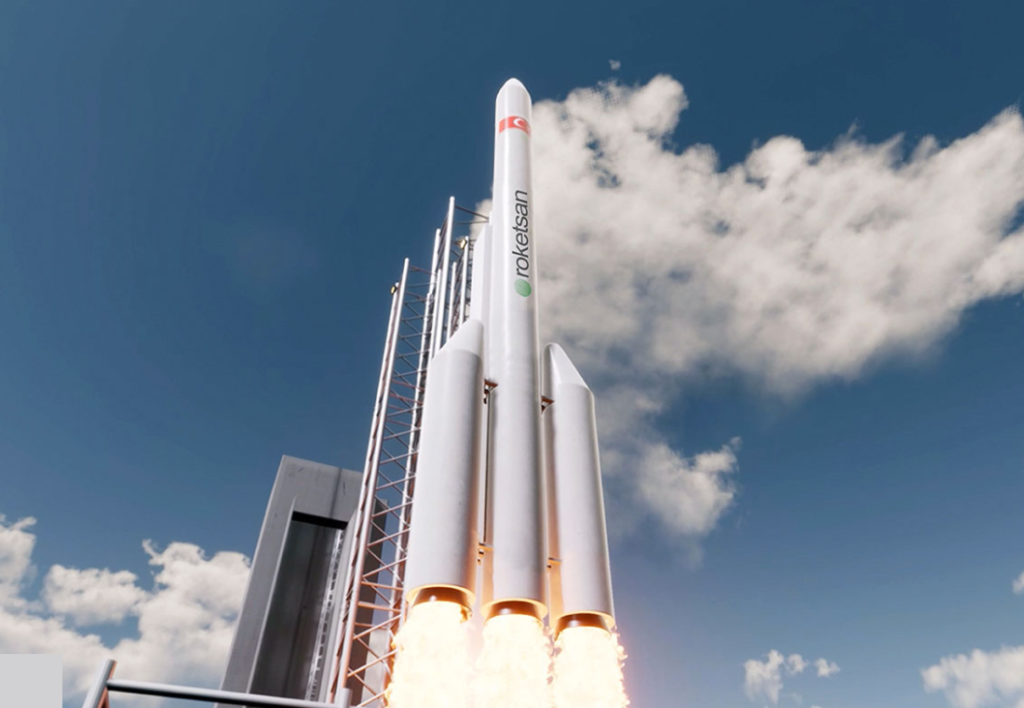There is a close technical relationship between sounding rockets and ballistic missiles. In the context of Turkey’s enhanced long-range strike capabilities, the topic of whether it is developing ballistic missiles with a range of more than 1,000 kilometers has once again sparked discussions.
Turkey recently reported that Turkey launched a domestically-made SR-1 sounding rocket in Ignada, Kerklareli Province in the northwestern part of the country. The rocket was developed and produced by the Turkish military enterprise Roketsan, with a target altitude of 550 kilometers.

Sounding rockets and ballistic missiles
In recent years, Turkey has expanded its influence in the Middle East in recent years, and its attention to Central Asia has also increased day by day. Its foreign policy is often described by the West as “Neo-Ottomanism”. Although it is a medium-sized country, Turkey has a “dream of a big country” Specifically, in the field of military industry and aerospace, the rapid development of military technology, TF-X “Khan” stealth fighter jet, “Banner” reconnaissance and strike drone, “Island” class frigate and various types of land combat weapons, many weapons Also exported to foreign countries. Between 2018 and 2022, Turkey’s share in the global arms trade rose from 0.6% to 1.1%, and it has become the 12th largest arms exporter in the world, which is impressive.
As the field that best demonstrates a country’s strength and status, Turkey will naturally not turn a blind eye to aerospace. In fact, Turkey has paid attention to the use of space since the 1990s, but technological development has been relatively slow. It was not until Erdogan came to power that the emphasis was raised to an unprecedented level. In 2021, Turkey successively announced the “Ten-Year Space Program” and the “2022-2026 Space Strategic Plan”, hoping to enhance global competitiveness through the development of aerospace technology and industry. In 2021, Turkey will establish a space agency to coordinate Turkey’s aerospace research activities, and to certify and supervise related activities. The Turkish Space Agency declared that Turkey needs to make a difference in the space field, “If we do not enter space, we will be doomed to poverty.”

In order to enhance its aerospace capabilities, Turkey has proposed opportunities such as satellites, manned spaceflight, lunar exploration and launch vehicles. In terms of launch vehicles, Turkey, like other countries that have successfully entered space, also started with sounding rockets. In 2018, Turkey successfully launched its first sounding rocket. The SR-1 sounding rocket launched this time has a carrying capacity of about 100 kilograms and a shooting height of 500 kilometers. Following the SR-1 sounding rocket, Roketsan will continue to work on the development of the ŞıMŞEK series of launch vehicles. The ŞıMŞEK-1 launch vehicle has a payload of 400 kg and aims to reach an altitude of 550 km in 2027, followed by the more advanced ŞıMŞEK-2 launch vehicle. According to official information, the average annual budget of the Turkish Space Agency is 50 million US dollars. According to Turkish media reports, in order to realize the manned spaceflight program, Turkey may invest 1 billion US dollars.
Some analysts pointed out that Turkey’s development of sounding rockets is not only for the purpose of overcoming launch vehicle-related technologies, but also for the development of medium-range ballistic missiles and even long-range missiles. There is a close technical connection. If the load of the sounding rocket is replaced with a warhead and a guidance system, it can become a ballistic missile. On the other hand, Turkey has actively developed ballistic missiles in recent years and has successfully tested ballistic missiles over 500 kilometers away. , it is reported that Turkey is developing a ballistic missile with a range of thousands of kilometers. It is worth mentioning that the company that develops ballistic missiles in Turkey is Roketsan, which develops sounding rockets. Therefore, the current popular saying is: “You taste it, you taste it carefully.”

Türkiye vigorously develops ballistic missiles
In October last year, a missile test in Turkey aroused great concern from the outside world. In the same month, Roketsan announced that the new Typhoon ballistic missile it had developed had successfully tested the missile. The missile flew for a total of 458 seconds after ignition and successfully hit the target area at a distance of 561 kilometers. This is the longest-range ballistic missile launch in Turkey’s history. If Western standards are used, the missile can be classified as a medium-range ballistic missile (more than 500 kilometers). In March of this year, Roketsan conducted another test launch of the “Typhoon” missile.
The start of Turkey’s ballistic missile technology can be traced back to the B-611 short-range tactical ballistic missile imported from abroad. Based on this missile, Turkey imitated the J-600T “Yildirim” missile, and the research and development work started in 1998. The J-600T missile is 6.75 meters long, has a projectile diameter of 610 mm, a warhead weighing 380 kg, and a range of about 150 kilometers. It adopts a strapdown inertial guidance system, and its hit accuracy is within 150 meters. On the basis of the J-600T, Turkey has developed the “Khan” tactical ballistic missile, with a range increased to 280 kilometers. The launch vehicle uses an 8-wheel truck chassis, and each launch vehicle carries 2 ready-to-launch missiles. The firepower has been improved. Doubled, and the use of a launch box, compared with the J-600T exposed body, can better store missiles. In addition, the “Khan” missile adopts a composite guidance method of inertial navigation + GPS satellite guidance, and the hit accuracy is about 35 meters. On the basis of the “Khan” missile, Turkey launched a foreign trade version – “Bora” (BORA) ballistic missile.

Turkey has not released specific information about the “Typhoon” missile, only the launch video. Judging from the launch screen, the “Typhoon” missile and the “Khan” missile use the same chassis, and the shape of the missile launch box is similar to that of the “Khan”. , the “Typhoon” missile is likely to be an extended-range version of the “Khan” missile. It may increase the length of the missile body and increase the fuel. In addition, it is possible to use lighter body materials and warheads to increase the range of the missile by 500 more than one kilometer. According to the analysis, the maximum range of the “Typhoon” missile is 600-700 kilometers, and the weight of the warhead is about 250 kilograms (the warhead of the “Khan” missile weighs 480 kilograms). Within 30 meters.

With reference to the development route of Iran’s “Conqueror” series of missiles, Turkey can also develop a medium-range ballistic missile with a range of 1,000 kilometers based on the “Typhoon” missile. The projectile diameter of -313 is increased from 610mm of “Conqueror”-110 to 680mm, and the length of projectile body is increased from 8.8m to 10.3m), which can increase the range of the missile. The solid sounding rocket project can verify related solid rocket motor technology and lay a technical foundation for the future development of ballistic missiles with thousands of kilometers or even long-range ballistic missiles.
deter surrounding opponents
The military purpose of Turkey’s development of medium-range ballistic missiles is to enhance its long-range strike capability. Before having this weapon, Turkey could only rely on the air force for long-range strike. The proliferation of missiles, drones, and ballistic missile technology has opened up new opportunities for many middle powers. For example, countries such as South Korea, Iran, and Japan are not equipped with nuclear weapons, but they all vigorously develop conventional ballistic missiles and cruise missiles, and have a certain strategic strike force. With this kind of strategic strike force, even big countries will have more confidence, just like Iran, because it has a large number of ballistic missiles and cruise missiles, even if Iran launches missile strikes on US military bases in Iraq, the US It can only respond through cyber attacks and words. On balance, there is no real war with Iran in the end.
At present, Turkey has made great achievements in the development of unmanned aerial vehicles, especially the integrated reconnaissance and strike drones. The TB-2 “Bannerman” reconnaissance and strike unmanned aerial vehicle developed by Baykal Technology Company has even sold well all over the world. Performed well in combat. With medium-range missiles, Turkey has another means of deterrence and strike. Especially in the early stages of war or military conflict, medium-range missiles and drones can act as “door kickers” to attack the opponent’s command center , airports and air defense facilities and other key targets. In my opinion, Turkey has successfully developed a domestic subsonic anti-ship missile equipped with a small turbojet engine. The air-launched SOM air-launched cruise missile (with a range of more than 200 kilometers) has also been tested. In the future, it is likely to develop similar “Tomahawk” long-range cruise missile.
With medium-range missiles with a range of thousands of kilometers, Turkey has an asymmetrical combat power against its old enemy Greece. As we all know, Turkey and Greece have disputes over territory, sea, etc., and there have also been “feuds” in history, although both countries are in NATO In the organization, the armies of the two countries regard each other as “thorns in the eyes and thorns in the flesh”, and sometimes they fight each other. Although the size of the Greek army is smaller than that of Turkey, it has the support of many European countries. The United States has long wanted to offend both sides. Both countries have purchased large quantities of advanced US-made weapons. Therefore, the Greek army is not an opponent that the Turkish army can underestimate. In order to gain an advantage in the game, Turkey has accelerated the development of asymmetric combat power in recent years, vigorously developing unmanned aerial vehicles, ballistic missiles and cruise missiles. With medium-range missiles, Turkey will have a missile strike force covering the entire territory of Greece, and Russia’s Black Sea coast and many countries in the Middle East are also within the scope of deterrence.
Source : thepaper.cn











Add Comment